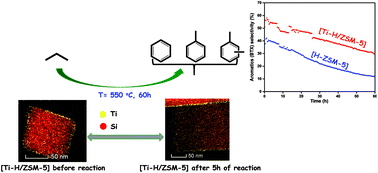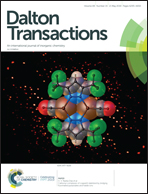A strategy to convert propane to aromatics (BTX) using TiNp4 grafted at the periphery of ZSM-5 by surface organometallic chemistry†
Abstract
The direct conversion of propane into aromatics (BTX) using modified ZSM-5 was achieved with a strategy of “catalysis by design”. In contrast to the classical mode of action of classical aromatization catalysts which are purely based on acidity, we have designed the catalyst associating two functions: One function (Ti-hydride) was selected to activate the C–H bond of propane by σ-bond metathesis to further obtain olefin by β-H elimination and the other function (Brønsted acid) being responsible for the oligomerization, cyclization, and aromatization. This bifunctional catalyst was obtained by selectively grafting a bulky organometallic complex of tetrakis(neopentyl)titanium (TiNp4) at the external surface (external silanol (![[triple bond, length as m-dash]](https://www.rsc.org/images/entities/char_e002.gif) Si–OH) group) of [H-ZSM-5300] to obtain [Ti/ZSM-5] catalyst 1. This metal was chosen to activate the C–H bond of paraffin at the periphery of the ZSM-5 while maintaining the Brønsted acid properties of the internal [H-ZSM-5] for oligomerization, cyclization, and aromatization. Catalyst 2 [Ti–H/ZSM-5] was obtained after treatment under H2 at 550 °C of freshly prepared catalyst 1 ([Ti/ZSM-5]) and catalyst 1 was thoroughly characterized by ICP analysis, DRIFT, XRD, N2-physisorption, multinuclear solid-state NMR, XPS and HR-TEM analysis including STEM imaging. The conversion of propane to aromatics was studied in a dynamic flow reactor. With the pristine [H-ZSM-5300] catalyst, the conversion of propane is very low. However, with [Ti–H/ZSM-5] catalyst 2 under the same reaction conditions, the conversion of propane remains significant during 60 h of the reaction (ca. 22%). Furthermore, the [Ti–H/ZSM-5] catalyst shows a good and stable selectivity (55%) for aromatics (BTX) of time on stream. With 2, it was found that the Ti remains at the periphery of the [H-ZSM-5] even after reaction time.
Si–OH) group) of [H-ZSM-5300] to obtain [Ti/ZSM-5] catalyst 1. This metal was chosen to activate the C–H bond of paraffin at the periphery of the ZSM-5 while maintaining the Brønsted acid properties of the internal [H-ZSM-5] for oligomerization, cyclization, and aromatization. Catalyst 2 [Ti–H/ZSM-5] was obtained after treatment under H2 at 550 °C of freshly prepared catalyst 1 ([Ti/ZSM-5]) and catalyst 1 was thoroughly characterized by ICP analysis, DRIFT, XRD, N2-physisorption, multinuclear solid-state NMR, XPS and HR-TEM analysis including STEM imaging. The conversion of propane to aromatics was studied in a dynamic flow reactor. With the pristine [H-ZSM-5300] catalyst, the conversion of propane is very low. However, with [Ti–H/ZSM-5] catalyst 2 under the same reaction conditions, the conversion of propane remains significant during 60 h of the reaction (ca. 22%). Furthermore, the [Ti–H/ZSM-5] catalyst shows a good and stable selectivity (55%) for aromatics (BTX) of time on stream. With 2, it was found that the Ti remains at the periphery of the [H-ZSM-5] even after reaction time.



 Please wait while we load your content...
Please wait while we load your content...